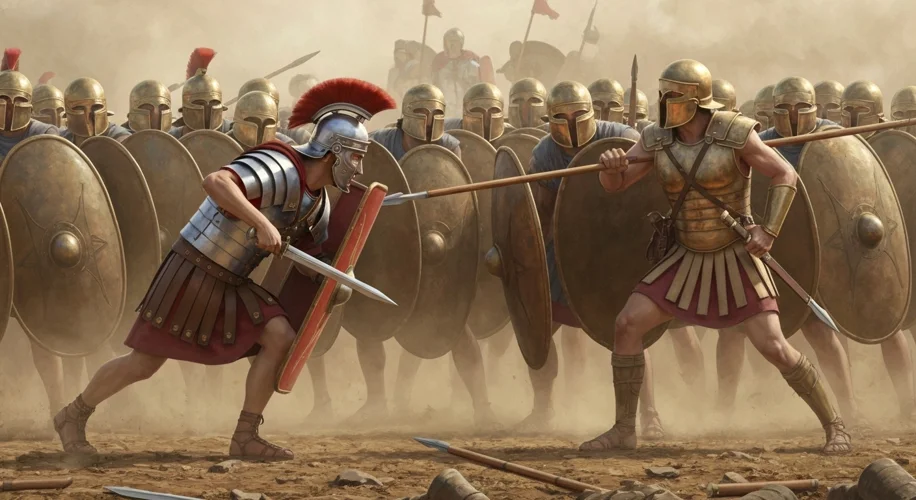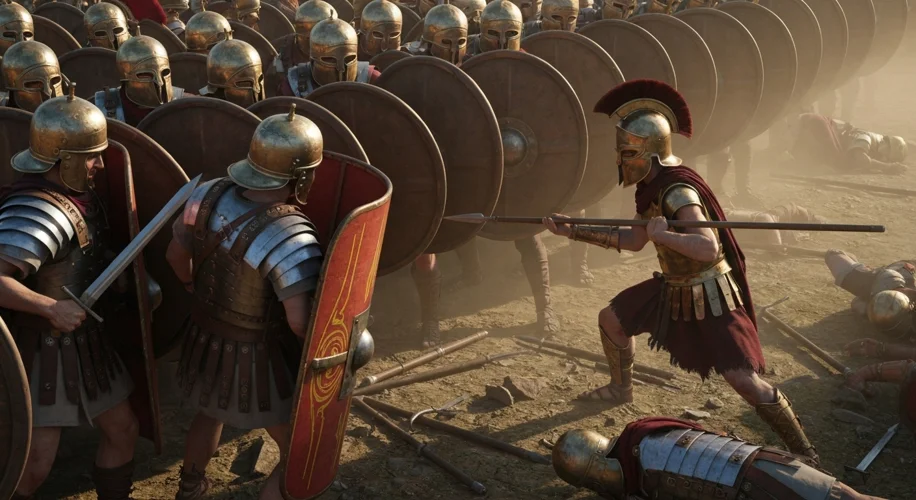The dust settled, a gritty veil over a landscape forever altered. The year is 197 BCE, and the plains of Cynoscephalae, Greece, are about to witness a collision of military titans. On one side stand the disciplined, sarissa-wielding phalanxes of Macedon, inheritors of Alexander the Great’s legacy. Facing them, the evolving legions of the Roman Republic, their formations leaner, their equipment more adaptable.
For centuries, the Greek hoplite phalanx had been the undisputed queen of the battlefield. Imagine hundreds, even thousands, of men locked in a bristling wall of bronze and ash wood. Each hoplite was a hoplite, a citizen-soldier armed with a spear (the dory), a large round shield (aspis or hoplon), a short sword (xiphos), and greaves. Their strength lay in their collective power. Shields overlapped to form an almost impenetrable barrier, with the sarissa, a formidable 13- to 18-foot pike, held by the front ranks projecting deadly points forward. The phalanx advanced as a single, terrifying entity, a rolling wave of death.

The Roman army, however, was a testament to pragmatic evolution. While their early legions might have resembled the phalanx, by the time of the Pyrrhic and Macedonian Wars, they had developed a more flexible system. At the heart of the Roman fighting force were the hastati, the youngest and often least experienced citizens, deployed in the front line. They were equipped with a pilum, a heavy javelin designed to bend upon impact, rendering enemy shields useless. Their primary weapon was the gladius, a short, stabbing sword, perfect for close-quarters combat. Crucially, they carried a large, curved rectangular shield, the scutum, which offered excellent protection.
Behind the hastati stood the principes, the more seasoned soldiers, and further back, the triarii, the veteran heavy infantry, often armed with spears. This maniples system, smaller than the phalanx, allowed for greater maneuverability. Instead of a single, rigid block, the Roman army could deploy in a checkerboard formation, allowing for gaps where the reserves could advance or where a struggling line could withdraw and reform.
The clash at Cynoscephalae was a brutal illustration of these contrasting philosophies. The Roman consul, Titus Quinctius Flamininus, faced the Macedonian king, Philip V. Initially, the Macedonian phalanx, with its vast expanse of sarissas, seemed to have the upper hand, pushing back the Roman hastati. The sheer length of the pikes made it difficult for the Romans to close the distance and effectively use their gladius.
But here is where the Roman adaptability shone. On one flank, the Roman right wing had gained a slight advantage and broke through a gap in the Macedonian line. Seeing an opportunity, a Roman tribune, Gnaeus Baebius Tamphilus, took matters into his own hands. He detached 2,000 men from the reserve and sent them to attack the Macedonian rear. The phalanx, designed for frontal assault, was notoriously vulnerable from the flanks and rear. The men, unable to turn their long sarissas to defend themselves, were cut down by the nimble Roman legionaries wielding their deadly gladii.
This tactical masterstroke proved decisive. The Macedonian center, locked in a desperate struggle with the Roman front, saw their flanks collapsing. Panic ensued. The phalanx, once a symbol of invincibility, dissolved into a disorganized rout. The Romans, with their flexible maniples and superior close-combat weapons, exploited the weakness mercilessly.
The consequences of Cynoscephalae were profound. It marked the beginning of the end for the Hellenistic kingdoms and the ascendance of Rome as the dominant power in the Mediterranean. The victory demonstrated the superiority of the Roman military system, with its emphasis on discipline, adaptability, and combined arms, over the more rigid, albeit powerful, phalanx.
It wasn’t just about which weapon was sharper or which formation was more aesthetically pleasing. It was about how an army could respond to the chaos of battle, how it could exploit weaknesses, and how its soldiers were trained and equipped to fight in diverse terrain and against varied enemies. The battle of Cynoscephalae, and others like it, were not merely contests of strength, but laboratories of warfare, where innovation and adaptation paved the path to empire.

